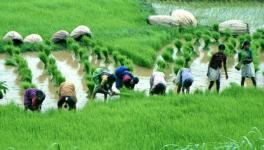PM-Kisan: Another Farmer Scheme that Needs Implementation
Farmers are a priority for governments around the world. In the United States, the department of agriculture is funding a programme to train people who work with farmers to recognise the signs of stress and connect those who need it with professional help. In India as well, the government has notified steps to assist farmers. India recently announced that the fourth instalment of its flagship income support scheme, Pradhan Mantri Kisan Samman Nidhi or PM-KISAN, would be credited to farmer’s Aadhaar-linked bank accounts.
PM-KISAN is a 100% central government-funded scheme launched in February 2019 that provides Rs 6,000 a year to farmers in three instalments of Rs 2000 each.
-
The scheme has been given a retrospective application, from 1 December 2018, while the cut-off date for determining the eligibility of beneficiaries is 1 February 2019. Benefits are also meant to be transferred if there is a change in ownership of land.
-
“Family”, for the purposes of the scheme, means a husband, wife and minor children. The number of beneficiaries for 2018-19 was estimated on the basis of the Agricultural Census of 2015-16. This projected number stands at 12.5 crore after excluding certain higher economic strata farmers from its benefits.
-
For the financial year 2018-19 a total Rs 20,000 crore has been sanctioned and it is estimated that Rs 75,000 crore will be spent on the scheme in 2019-20.
-
The scheme’s beneficiaries were allowed use alternative documents to receive the first instalment, of FY 2018-19, but now Aadhaar has been made compulsory, except in Assam, Meghalaya and J&K, where other documents will work until 31 March 2020.
-
The Centre will implement the scheme, except on identifying the families. Central Project Monitoring Units and a Monitoring Committee headed by the cabinet secretary manage the implementation.
The objective of the scheme is to augment the income of Small and Marginal Farmers (SMFs). Any farmer who cultivates less than 2.0 hectares falls within its ambit. It aims to supplement the cost of procuring farm inputs and, in addition, aims to help farmers avoid the clutches of money lenders. This government also has a hardcore belief in Direct Benefit Transfers or DBT, a possible reason why this scheme was launched. PM-KISAN has been regarded by some as a first step towards universal basic income or UBI, a possible safety net against sudden loss of income.
Giving the marginal farmers an assured income, needless to say, can benefit the economy on the whole. However, there is a need to consider the other side of the PM-Kisan coin. People getting it might want to use it for some other purposes rather than using it for the land, for example, buying gadgets or other household items. It has often been pointed out that in the absence of clear safeguards, the income from PM-KISAN may end up being used for alcohol consumption as well.
There are implementation issues in the scheme too. Every year there are three periods—once every four months—during which the instalments are to be credited. But a farmer who enrols in the scheme in the middle of a year, will lose out on other instalments delivered to beneficiaries that year. Data also shows that people are not aware of this scheme, and that generating awareness and rolling out the scheme is taking time.
Total enrolments, at the end of October 2019, as per data of the Union Ministry of Agriculture and Farmers’ Welfare (MoAFW), stands at 7.62 crore, far short of the target to cover 12.5 crore farmers. In addition, the benefit of the scheme is only available to farmers who cultivate up to 2 hectares of land. Therefore, the government has missed out on other farmers which include tenant farmers and landless labours.
Aadhaar is yet another bane for implementing DBT schemes in India. Compulsorily linking Aadhaar was put off till November 2019, but now the government is pushing hard for this. Hence, only those farmers will be able to avail the scheme who have bank accounts and Aadhaar numbers and have linked the two. The Indian government has tried hard to link Aadhaar with bank accounts, but it is too early to impose such a stringent condition on farmers.
Recent surveys have pointed out that most Indians have certain beliefs related to Aadhaar which are not rooted in fact or law. Also, considering the widespread lack of awareness, it would be tough to expect all farmers to comply with linking their bank accounts, since all bank accounts have not been linked yet.
There is a lot PM-KISAN can learn from KALIA or the Krushak Assistance for Livelihood and Income Augmentation, a scheme approved by the Odisha state cabinet last November. This scheme is meant to provide Rs 5,000 per SMF, twice a year, or Rs 10,000 a year, and build on it.
PM-KISAN will need refinement, for any scheme depends more on the authorities who implement it than the ones who draft it. For the time being, the accrual of benefits could be made easier. Besides, the income itself can be raised. Some time back, there were reports that the income would be raised to Rs 8,000 but nothing has come of it so far. Moreover, the mechanism for registering farmers should be easier. In over a year since its launch, the scheme could have enrolled almost 10 crore farmers, but the performance is lower than 7.62 crore. Last year, it became clear that only 21% of farmers got the second instalment. Finally, state governments should implement the scheme keeping aside political rivalries, which can cause delays in implementation of any scheme.
The author is a student at the National Law University, Jodhpur. The views are personal.
Get the latest reports & analysis with people's perspective on Protests, movements & deep analytical videos, discussions of the current affairs in your Telegram app. Subscribe to NewsClick's Telegram channel & get Real-Time updates on stories, as they get published on our website.
























